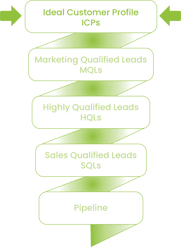The goal of building a successful brand revolves around an ideal of forging strong relationships that last. But how’s a company to get there, especially when they’re still figuring out what the process involves?
The method for creating those almost perfect scenarios has a lot to do with what’s going on behind the scenes. To achieve any of these, very doable, goals you must first examine what you want to achieve and who you want to sell your product/service to.
This is where an Ideal Customer Profile comes in to save the day (and keep you organized throughout the process). Our step by step guide will help you to create your Ideal Customer Profile and answer any other related questions along the way.
|
Green Leads On: Ideal Customer Profiles
|
What is an Ideal Customer Profile?
An ICP has less to do with an individual, and everything to do with finding a fictitious business that has all of the qualities that would make them perfectly matched for the products and/or services you have to offer.
It’s basically about your company finding a perfect match. The best way to do that is to create an ICP that fits your ideal situation and then measure it up against leads. This ensures that you are following a designated, and fully aligned plan of action when determining if a lead fits the necessary criteria you initially set out.
Differences Between an Ideal Customer Persona and a Buyer Persona
Think of an ICP as the broad outlook based around a general understanding of your ideal customer. A buyer persona is similar in intention, yet the focus is on a person within that target company. The ICP becomes your broad umbrella and a buyer persona becomes the targeted person beneath the umbrella.
All of the concepts work together to frame your company’s offerings. You can also look at the two as being driven by different purposes.
The ICP is based on specific qualifications through data and other important metrics like financials and sales. A buyer persona includes qualitative information that cannot be measured in the same way. This information teases out the importance of your buyer’s goals, challenges, purchasing power, and other qualitative data.
When used in tandem, an ICP and a buyer persona provide a fuller overview of who you are targeting. The combination is also a great way to keep track of and foster brand loyalty from a macro and micro level.
Why Are Ideal Customer Profiles Important?
ICP’s are incredibly important when it comes to defining a clear, cohesive vision for your marketing and sales teams. It’s easy to get caught up with what you want to achieve, but the path there is never as simple. You can use an ICP to find a middle ground between information that is too broad or even too specific depending on what you’re trying to achieve.
Increase Sale Cycle Speed
Your sales cycle is largely dependent on your ability to automate tasks, execute actionable goals, and focus on data-driven performance. An ICP essentially formalizes your method to ultimately yield better results. You can increase your sales by paying attention to the customer profiles you have built. Let’s say you want to speed up your process, well, before you can jump in to fix something it’s probably best to figure out the “why” behind it. You can figure out pain points for customers and weed out unnecessary processes that hinder the end result.
It’s actually an interesting two-fold effect because as you better understand and serve your customer based on customer profile data, you can also have an impact on your own success. It’s essential to take the time to build out your customer profile just as you would streamline efficiency in sales.
Improve Customer Lifetime Value
The goal of any brand is to create long valued relationships with customers. However, this is not easily achieved. Today a great deal of brand loyalty is based around trust, which is why transparent practices are so important for the health of your business and your customer as well.
You must foster this relationship early on to eventually figure how your customer fairs over time. Ask yourself, are they continuing to come back? Have they fallen off from purchasing or utilizing certain services? Ask yourself many questions to think about what your customer is possibly thinking.
In order to improve this relationship you should also keep in mind:
- Engagement - Are you offering valuable content that emphasizes your product or service in the best light? Perhaps think about creating a newsletter to update customers. Here you can target key issues or even personalize content to reflect the intended customer profile.
- Customer Service/Support - Do you have a dedicated support staff or system to respond to questions? Or, do you have a live chat support option to offer immediate responses? It’s worth considering how you interact with customers and if they would benefit from seeing a support team option.
- Education - Do you offer material that explains your offerings? A blog, podcast, or white papers and case studies are great ways to showcase your products/services while also educating your customers about your capabilities.
How Do You Create an Ideal Customer Profile?
An ICP varies depending on your company and the products/services you offer. It’s important to think about firmographics when looking at your account attributes. These attributes differ from demographics and are often used in the Software as a Service (SaaS) world to understand the industry, location, size, status/structure, and performance of the business you’re looking to build an ICP for. While you can go about the process depending on your situation, we’ve further broken out some important firmographic points to consider.
- Industry or Sector - Are you looking to place your product/service in a specific industry? Or are you looking for a broad approach?
- Revenue and Size - What is the budget/company size that will use your product/service?
- Location - Do you only sell to a certain region? Do you want to expand your region to national, or even international offerings?
- Legality - Will your customers face any legal limitations through their experience?
- Product or Service Limitations - Do you have a set timeline to deliver your product/service? And, do you have a Service Level Agreement (SLA) with your customer?
Create your customer journey map
A customer journey map illustrates how your customer engages with and goes through your company. This can be broken down into products you offer, experiences, services, or a combination of all of those offerings. You want to align your customer’s needs and track how they are responding to your offerings.
Some companies break down their map into actionable stages (ex: awareness all the way to brand loyalty) to see how a customer would interact with your brand over time.
 \
\
Create Customer Personas
Think of a customer persona as a fictional archetype that represents:
- Who your customers are
- What they want to buy, learn, receive etc.
- What their goals and behavior are
- What they’re thinking about
- How they interact with the brand
- Why they make the decisions they do
Your customer persona is key to understanding who your customers are from a basic level, but then also the psychology behind decisions. You can also use data to inform a lot of this information. The best customer personas use quantitative and qualitative data to find real reasons behind purchasing decisions among other points.
Sort and Analyze your best Customers
Data driven customer personas help to support current and future customer needs. This can be broken down into several categories including:
- Demographics - This is a broad category that includes the basic information initially gathered (Age, Sex, Job Title, Income, Education, Family)
- Psychographic - This category includes psychological factors that are important to understand why someone may or may not purchase something. You can also look into the customer journey here to figure out what might be going through a customer’s mind.
- Behavioral - This is similar to psychographic data, but includes qualities like engagement, use, and even brand loyalty.
You can use this data to inform and update your customer personas over time.
Focus on the problem you are trying to solve
Problem solving is a huge part of marketing anything to a new customer or business. However, in order to do that you must be willing to examine the problems that exist in the marketplace or specific to your customer personas. You should clearly identify and define your goals for solving the problem at hand. For example, let’s say you find that you’re having an issue with engagement. A lot of your ICP should revolve around finding solutions for this issue. In the end, your business and your customers will be better off thanks to your critical thinking ahead of time.
Analyze Feedback: Both Good and Bad
Everyone likes good feedback. It makes us feel like we’ve accomplished something, but without bad feedback we can never grow. Take the time to analyze all of your feedback to see what’s working and what could be improved. Remember, you might think that you’re golden with what’s being offered, but your customer could have a completely different idea.
That’s why it is so important to do background work like creating a journey map and personas. You can tease out potential conflicts and come to better understand how to offer your products or services. A lot of this involves taking a step back and examining your trajectory from different perspectives.
What do I do with a customer profile?
An ICP helps to focus in on particular areas that need attention. You can also better identify how your product/service can benefit your intended ICP. This is similar to a more modern approach of personalization. Now, we let data inform us on potential trends, but also strive to create better experiences.
User Experience has become a hot topic throughout industries looking to better serve their customer base. More than ever, companies need to pay attention to how a product or service is being consumed. It’s no longer just about the efficiency, but what is the takeaway after that experience, and can it be replicated.
Getting Started with Green Leads
At Green Leads we know how important your ICP is, which is why we work to help you streamline the process. By combining the ICP criteria with your target Persona criteria, Green Leads can create the target ICP list of both accounts and contacts for use in nurturing, targeting, and engaging with. Our data specialists query and research our 60 million names and pull from the database to build your list. Optionally, you can have our team add additional value to the list through:
- Phone validation
- Email deliverability
- LinkedIn profile URLs
These deliverables become actionable information that only work to better inform your data and ICP aims. For more information on ICP best practices, check out our Ideal Customer Profile Persona Leads page.
But if you’re looking to get started today, let’s schedule a call and talk pipeline, or any other ICP needs for your organization. Afterall, a thirty minute pipeline generation discovery call could be the first step to ultimately delivering revenue.



.png?width=212&name=GREEN%20LEADS%20(3).png)



